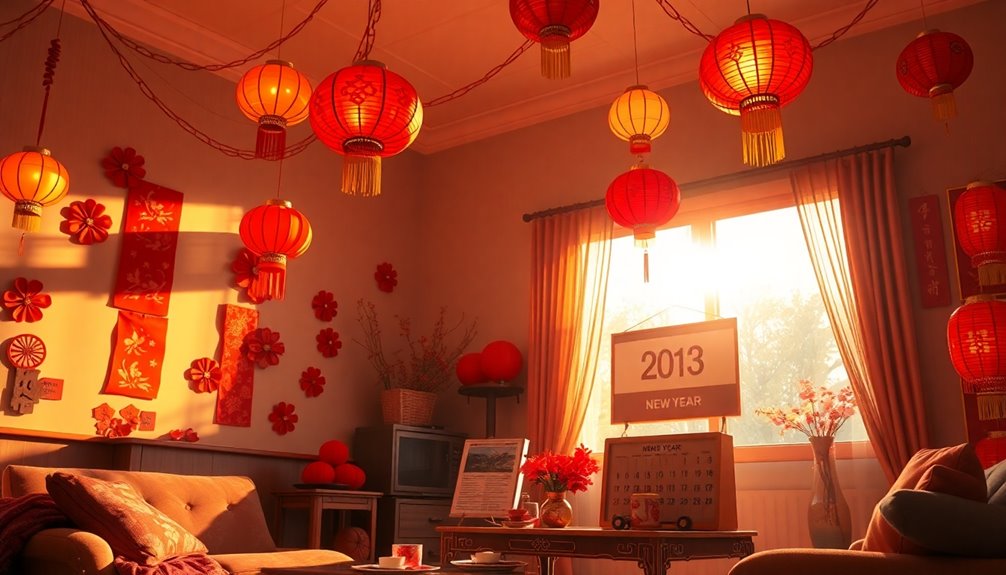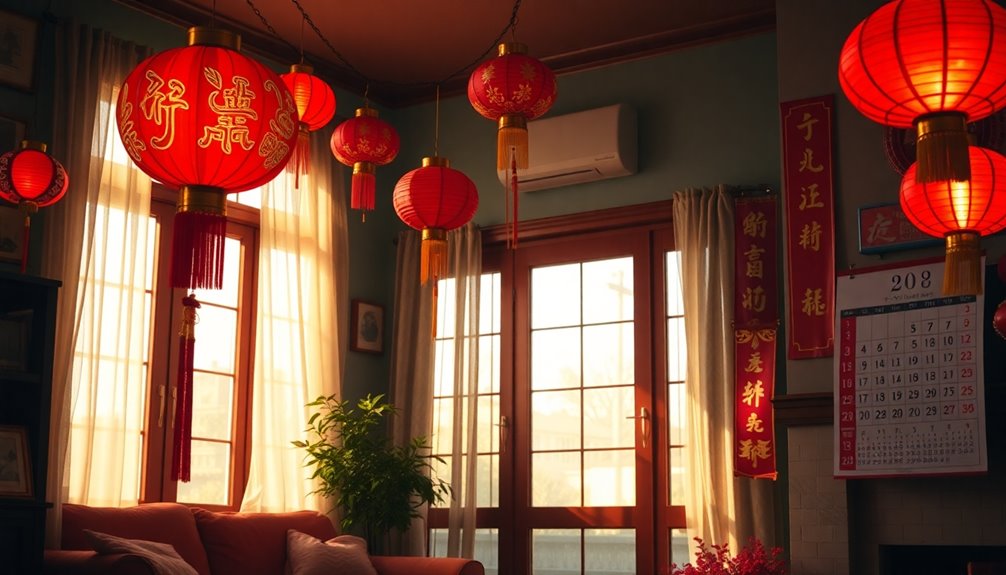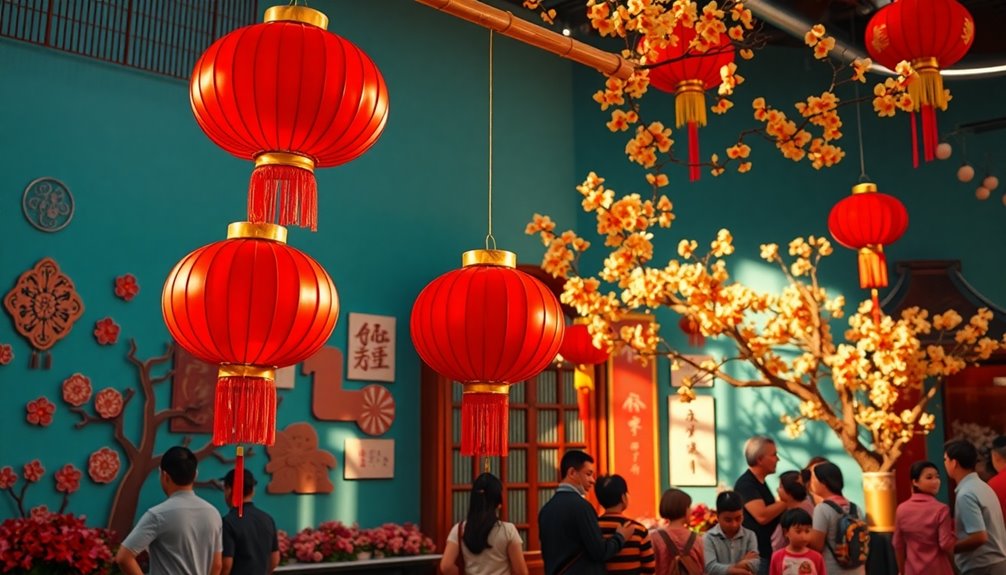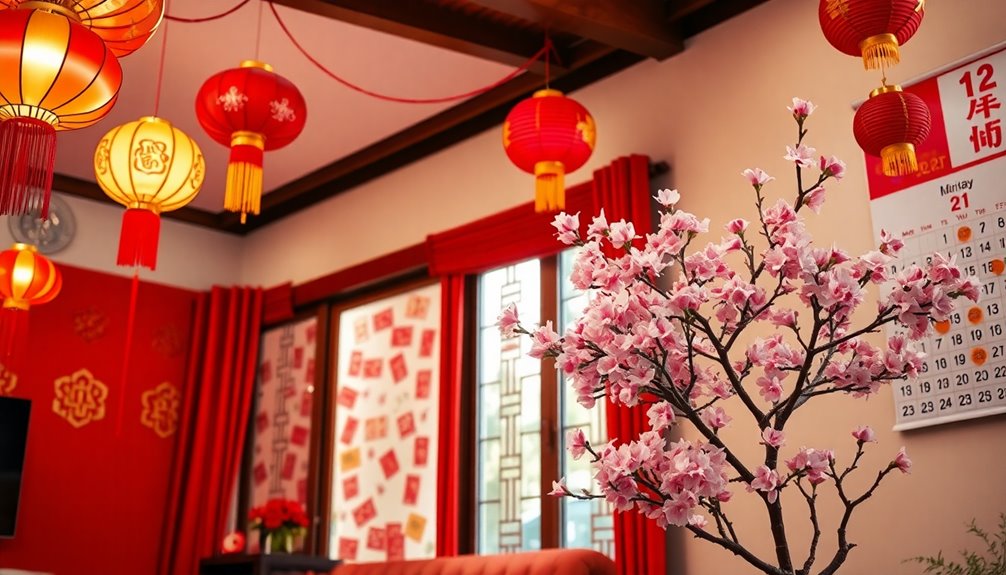To create a vibrant celebration for Chinese New Year, you should hang your decorations three to four weeks before the Lunar New Year. This timing not only builds excitement but also brings an auspicious atmosphere to your home. Make sure to check the specific date each year; popular symbols like Chinese knots, red lanterns, and auspicious plants will enhance your decorations. It's traditional to leave these up until after the Lantern Festival, marking the end of festivities. Leaving them up longer can keep the joyful spirit alive. If you're curious about the cultural significance and variations, there's more to explore ahead.
Key Takeaways
- Start decorating 3-4 weeks before Lunar New Year to build excitement and festive spirit.
- Keep decorations up until after the Lantern Festival to enhance the celebratory atmosphere.
- Regional variations exist: Southern China decorates early, while Northern China may start a week before.
- Modern trends show families sometimes begin decorating mid-January or during the last week of December.
- Avoid removing decorations too early, as it may be considered inauspicious in traditional beliefs.
Best Time to Hang Decorations

When it comes to hanging Chinese New Year decorations, you'll want to start about 3-4 weeks before the Lunar New Year to truly set the festive mood. This timing helps build excitement and anticipation for the celebrations ahead.
Since the Lunar New Year date changes each year, it's important to check a calendar for the specific day. You can fill your home with vibrant Chinese knots, Fai Chun, and firecrackers, all symbolizing good fortune and prosperity.
Don't forget to add auspicious plants like bamboo, chrysanthemums, and kumquat trees, which represent growth and abundance. By decorating early, you create an inviting atmosphere that captures the spirit of the season and prepares your home for joyful gatherings.
Duration of Display

As you immerse yourself in the festive spirit of Chinese New Year, contemplate keeping your decorations up until after the Lantern Festival, which falls on the 15th day of the Lunar New Year.
This duration of display not only enhances the celebratory atmosphere but also marks the official end of the festivities.
Here are some popular Chinese New Year decorations to contemplate:
- Chinese Knots for good fortune
- Spring Festival couplets for prosperity
- Auspicious plants symbolizing growth
- Lanterns lighting up the night
- Red envelopes for blessings
While many families take down their decorations after the Lantern Festival, some choose to leave them up longer to maintain that joyous spirit.
Just be mindful not to remove them too early, as it can be seen as inauspicious.
Cultural Beliefs and Timing

Hanging Chinese New Year decorations isn't just about adding color to your home; it's deeply rooted in cultural beliefs and practices.
You typically put up these decorations 3-4 weeks before the Lunar New Year to infuse your space with a vibrant and festive spirit. The exact timing can vary, so check the calendar to know when to start.
Popular symbols like Chinese Knots, Fai Chun, and firecrackers enhance the celebratory atmosphere.
However, be mindful of timing—removing decorations too early is considered inauspicious in some cultures. Traditionally, you take them down after the Lantern Festival, marking the end of festivities, but many choose to leave them up longer to prolong that joyful feeling.
Regional Variations in Timing

While many people start decorating for Chinese New Year weeks in advance, the timing can vary considerably across different regions of China.
Here's a quick breakdown of how regional variations affect your decorations:
- Southern China: Decorations go up 3-4 weeks early, focusing on auspicious plants like kumquat trees.
- Northern China: You'll typically hang decorations just a week before, emphasizing traditional elements like couplets and paper cuttings.
- Urban Areas: Expect modern trends, with colorful lights and digital displays appearing as early as four weeks prior.
- Rural Regions: Families often stick to traditional practices, decorating just days before the New Year.
- Local Customs: Neighborhood celebrations can influence timing, leading to collective decorating efforts days or weeks in advance.
Modern Trends in Timing

With the excitement of the Lunar New Year approaching, many people start hanging decorations as early as mid-January, blending traditional practices with contemporary trends.
You might notice that some families embrace decorating during the last week of the Gregorian calendar year, merging Western New Year celebrations with their customs.
In urban areas, decorations often appear even earlier, around late December, especially in public spaces and shopping centers to attract festive shoppers.
Social media influences have also led to modern trends where individuals share their decoration timelines, fostering a community-oriented approach.
Plus, with rising eco-consciousness, many families are opting for sustainable materials, prompting them to plan their timing earlier to guarantee they're ready for the festivities.
Frequently Asked Questions
When Should You Put up Chinese New Year Decorations?
You should put up your Chinese New Year decorations about 3-4 weeks before the Lunar New Year. It creates a vibrant atmosphere and builds excitement for the festivities.
Since the exact date varies each year, check the Lunar New Year calendar to plan accordingly. Engaging in this activity with family not only fosters unity but also sets the tone for a joyous celebration filled with symbols of good fortune and abundance.
Where Do You Hang Chinese New Year Ornaments?
Imagine transforming your home into a vibrant tapestry of joy and fortune.
You can hang Chinese New Year ornaments in key spots to create that festive atmosphere. Place vibrant spring couplets on your front door to welcome guests and good luck.
Drape red lanterns from ceilings or porches to symbolize family unity. Adorn windows with paper cuttings and paintings, while decorative plants like kumquat trees breathe life and prosperity into your living space.
How to Put up Chinese New Year Decorations?
To put up Chinese New Year decorations, start by choosing vibrant colors, especially red, which symbolizes good luck.
Hang Spring Festival couplets on doorways, ensuring the text faces outward.
Place paper cuttings and red lanterns around your home for a festive feel.
Don't forget auspicious plants like kumquat trees and bamboo for extra symbolism.
Finally, make sure to position the upside-down 福 (fu) character above the couplets to enhance its meaning.
Enjoy the festivities!
When to Clean House for Chinese New Year?
As the old year fades like a distant memory, you're ready to welcome fresh beginnings.
You should start cleaning your house about one to two weeks before Chinese New Year. This act isn't just about tidying up; it's a ritual to sweep away bad luck and make space for good fortune.
Focus on key areas like the kitchen and living room, and remember to avoid cleaning on New Year's Day to keep the luck you've gathered.
Conclusion
So, if you're still waiting to hang those Chinese New Year decorations, remember: timing is everything! You wouldn't want to offend the kitchen god or invite bad luck by decorating too late, right? Just imagine the horror of being the person who puts up decorations after the New Year starts—what a faux pas! So grab those red lanterns and couplets early, because who wouldn't want to be the overzealous decorator in the neighborhood? Happy decorating!








